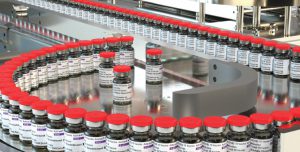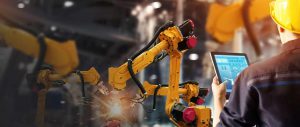Across the world, the Covid-19 pandemic has disrupted the global supply chain and exposed the limited resilience of many manufacturers. A few manufacturers have ceased production entirely, many have seen a demand reduction, and others have experienced a massive surge in demand. As a result, the need for manufacturing industries to step up performance and invest in smart factory production, also known as Industry 4.0, has never been greater.
According to an NAM survey report, 80% of the manufacturers expect the pandemic to create a financial impact on their business while 53% anticipate a change in their operations. Another report by UKG signifies the mounting skilled labor shortage that threatens to delay the sector’s full recovery.
With the pandemic consistently challenging the industry’s survival, manufacturers have realized the need to accelerate the adoption of new technologies by advancing their digital strategies. Prior to the pandemic, Industry 4.0 was only an exciting subject brimming with potential advantages. The pre-covid business drivers included cost reduction, competitive advantage, productivity, and sustainability. Today, the focus is on survival, damage limitation, recovery, and business as usual in the new normal.
A report suggests that the smart factory size is projected to reach USD 134.9 billion by 2026 from an estimated USD 80.1 billion in 2021. This further indicates how the manufacturing sector is set to adopt the smart factory, and other advancements sped up by the effects of the pandemic.
The role of an Industry 4.0 solution in the current pandemic and the new normal significantly includes:
 Helping the businesses with transportation complications
Helping the businesses with transportation complications
 Remote work
Remote work Help them easily handle unexpected high demands
Help them easily handle unexpected high demands Cope up with dynamic markets
Cope up with dynamic markets Help overcome downtime from delays
Help overcome downtime from delays
Industry 4.0 can quickly achieve this role due to the many capabilities it offers to the manufacturing sector. Companies that have not invested in smart factory advancements are likely to discover their future dependence on high-tech innovations, making their operations stronger and more efficient in the long run. On the other hand, those already invested are reaping the associated benefits.
For instance, a German ancillary which is a six-sigma compliant company and works with multiple raw materials suppliers, recently adopted a Smart Factory model to track and trace the movement of their goods. They implemented MOTIF, Motherson Technology Services Industry 4.0 analytics suite, for real-time anomaly detection and resolution and to improve the overall operational efficiency of their plants.
Having a fully interconnected manufacturing process certainly has the ability to disrupt the legacy methodologies and bring the greatest efficiency and productivity. Therefore, let’s understand the need for smart factories to which manufacturers are opening their factory doors as well as their pockets.
 Minimize rework and production defects: With smart solutions in place, any deviation from pre-determined specifications is impossible. Hence, rework is not required making the entire production cycle defect free.
Minimize rework and production defects: With smart solutions in place, any deviation from pre-determined specifications is impossible. Hence, rework is not required making the entire production cycle defect free. End-to-end visibility and real-time monitoring: In a smart factory, manufacturers can perform real-time monitoring and resolve the bottlenecks promptly. Also, they may trace and analyze the end-to-end process at any time for accuracy and efficiency.
End-to-end visibility and real-time monitoring: In a smart factory, manufacturers can perform real-time monitoring and resolve the bottlenecks promptly. Also, they may trace and analyze the end-to-end process at any time for accuracy and efficiency. Swift response to unforeseen challenges and dynamic market trends: With volatile and unprecedented market changes and challenges such as the ongoing pandemic, customer demands fluctuate. With With right insights derived from data and a in a smart factory setup, businesses are able to bring things into perspective and plan accordingly to achieve maximum efficiency.
Swift response to unforeseen challenges and dynamic market trends: With volatile and unprecedented market changes and challenges such as the ongoing pandemic, customer demands fluctuate. With With right insights derived from data and a in a smart factory setup, businesses are able to bring things into perspective and plan accordingly to achieve maximum efficiency. Coping up with skilled labor shortage: Attrition has been a persistent challenge in the manufacturing world, which Covid-19 has further intensified. However, with the adoption of smart factory solutions, manufacturers can prioritize investment in their workforces as a part of their digitization strategy.
Coping up with skilled labor shortage: Attrition has been a persistent challenge in the manufacturing world, which Covid-19 has further intensified. However, with the adoption of smart factory solutions, manufacturers can prioritize investment in their workforces as a part of their digitization strategy. Increased ROI: With a smart factory solution in place, the manufacturers may quickly analyze and correlate the production figures, thus knowing the potential areas for improvement in a factory, leading to an enhanced ROI.
Increased ROI: With a smart factory solution in place, the manufacturers may quickly analyze and correlate the production figures, thus knowing the potential areas for improvement in a factory, leading to an enhanced ROI.
As of now, several leading organizations have invested in digital factories of the future. They have embarked on their digital transformation journey, thereby drastically reducing their operational costs and increasing production efficiencies. A Dutch construction conglomerate, for instance, switched from their traditional manufacturing setup to a fully connected, flexible Smart Factory ecosystem with the help of Motherson Technology Services Industry 4.0 analytical suite and the warehouse management solution.
Many similar examples of smart factories showcase how it has benefitted them and helped them gain a competitive advantage in the market. The early adopters seem to have gained a lot from their investments and therefore, are in a comfortable space for the coming years.
It is clear that substantial change is coming, and the future looks promising.
About the Author:

Hariharan Ramakrishnan leads the Digital and Analytics services at Motherson Technology Services Limited. A multi-disciplinary business leader with 20 plus years of experience in the digital transformation space, he is instrumental in helping enterprises evolve their digital strategy to enhance their revenues whilst improving customer experience, and optimising cost. A frequent speaker at industry & technology forums, he continues to author various thought leading articles on technology related trends















































